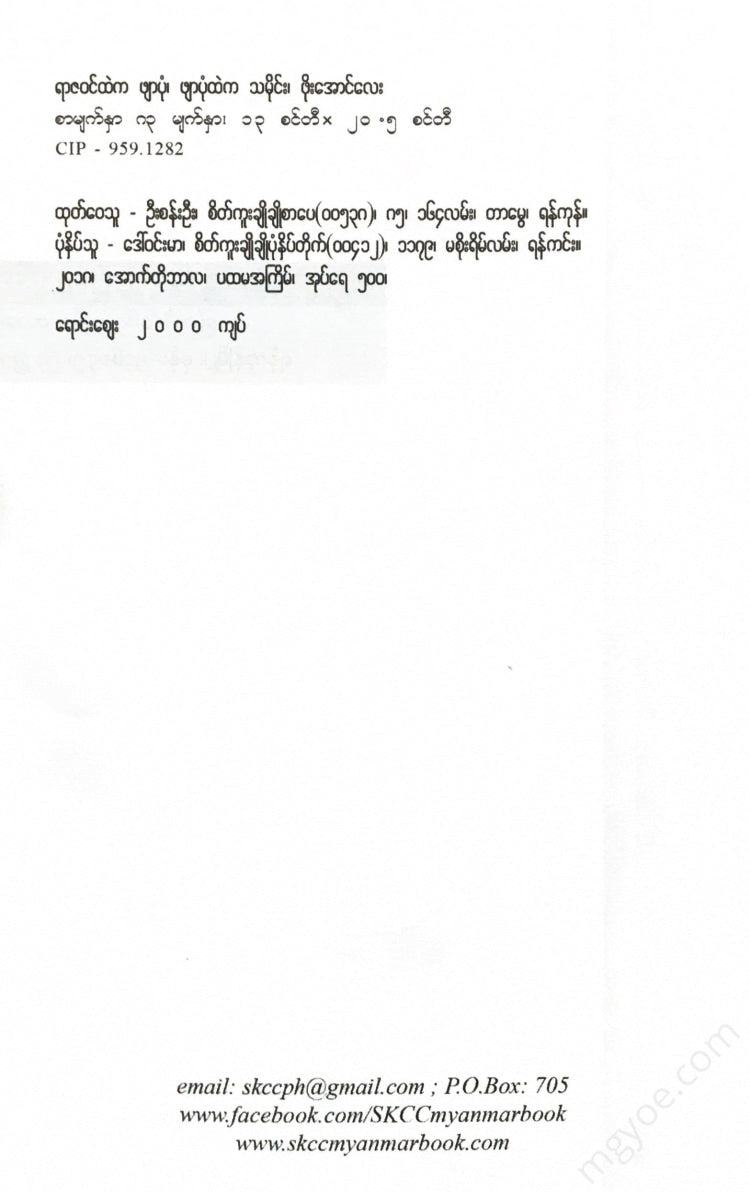စိတ်ကူးချိုချိုစာပေ
Pho Aung Lay - The history of the mat, the history of the mat
Pho Aung Lay - The history of the mat, the history of the mat
Couldn't load pickup availability
Pyapon Township is located in the southern Ayeyarwady Region of Myanmar, bordered by the Pyapon River to the east, Bogale Township to the west, the Gulf of Mottama to the south, and the Kyonta River to the north. It is a district town consisting of Deyde Township, which is separated by the Pyapon River to the east, Kyaiklat Township, which is separated by the Kyonta River to the north, and Bogale Township to the west.
Pyapon Township is located between (95°30) and (95°45) east longitude and (15°30) and (16°35) north latitude according to the map of Myanmar. At the confluence of the Pyapon River and other large and small streams, it extends from east to west (13.068) miles, from south to north (288977) miles, and has an area of (587.33) square miles, (375890) acres.
Pyapon Township faces the Pyapon River, a tributary of the Ayeyarwady River that flows into the delta region. It is located within four boundaries: Chaungdwin Village to the north, Ayang Village to the west, and Awkwingyi Village to the south. It is 10 miles from east to west, 3.5 miles from south to north, and has an area of 4.5 square miles.
Pyapon Township has a hot and humid climate with a minimum rainfall of (84) inches and a maximum of (105) inches. The minimum temperature is (18 °C) and the maximum is (39 °C). Although it is hot and humid, it is located close to the sea, so the temperature is balanced. It is (12) miles from the sea. The land surface is flat. The elevation above sea level is (9.35) feet.
Mon name vocabulary, Pyapon
Pyapon is a place where the ancient Mon people lived. The word “Pyapon” is not a Burmese word, but comes from the Mon language “Pyapon”, and in Burmese, “Pha” means “market” and “Pin” means “rice”. Therefore, Pyapon means “rice market”.
The location of the city is located at the confluence of the Pyapon River and other large and small streams. Therefore, in ancient times, when travelers wanted to visit the upper reaches of the river and the inner part of the river, they would wait for water at the mouth of the river flowing west when the water level was low. This place was a camp where travelers cooked and ate rice while waiting for water, and it is figuratively called “rice market” in the Mon language. It is not a shop that sells rice, nor is it a rice market. It is known that the ancient Mon people did not have a custom of selling rice. From the riverside camp where travelers and traders stopped on their journey, Pyapon Village and Pyapon City gradually developed. The original stopover at the riverside camp is where “Ayen Village” is now located.
The area that would become Pyapon in the early 16th century was an obscure region until the reign of King Shwe Htee of the Taungoo Dynasty. At that time, it was part of the three Mon states of Lower Burma, the Ramayana Division, and many towns and villages in the district had Mon names. It was also the area where the majority of the Mon people lived.
During the reign of King Tabin Shwe Htee of the Taungoo Dynasty in the 16th century (1530) of the Burmese calendar (892), the Mon people gradually began to form a small island in front of the riverbank and estuary called Pyapon, during the invasion of the Mon people in the lower Myanmar, Ramanayatain Hanthawaddy in the Burmese calendar (897) (1535). A small number of Mon people settled on the island, which gradually appeared from west to east, and the number of houses increased to the size of the island.
After living like this for a long time, the houses became so crowded that they could be called “Sha”, but the ruler and the government did not recognize the name “Sha”. There were only a few houses. It was just an unknown area. That period should be called the “prehistoric” period, when even the name “Pyapon Village” had not been established.
The first mat in history
In the “Maha Razawin Thit (Taung Ngu Era)” written by the Dwinthin Thayawun Maha Sithu U Tun Nyo, the year when Tabin Shwe Htee Min and Bayintnaung Kyaw Htin Nawrahta attacked the Mon homeland of Bagu (Pegu) is stated as Myanmar year (897), Christian year (1535). Around that time, the queen of the 11th generation of the Hanthawaddy Mon dynasty, Sushin Takarutpi, fled to the Pyapon region.
While the Queen was hiding in the Mayangone area on the eastern bank of the Pyapon River (now Dedede Township), in the Burmese year (899) and the year 1537, she erected and worshipped the “Mayangone” (Goddess of Life) called “Kyaik Han Praw” (Goddess of Life).
In the year in which the Pyapon “Marang Pagoda” (Kyaik Han Praw) was built and worshipped, when King Tabin Shwe Htee conquered Bago, the Mon queen, who had been hiding in the Mayangone area on the eastern bank of the Pyapon, crossed the Pyapon River and moved to a new location.
It is recorded in the unpublished manuscript of the Pyapon Chronicle that the Queen built a pagoda called “Kyaik Gachuam (Kyauk Ka Muam)” (Thetluat Chantha) on the headland of the Pyapon River, and worshipped there.
Now, the famous historical pagoda of Pyapon, the Layukone Kyokkamuang Thetluthchan Pagoda, can be said to be the first pagoda built and worshipped in Pyapon around the Burmese year (900) and the year (1538) according to the historical evidence mentioned above.
Share

















